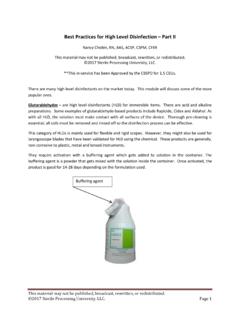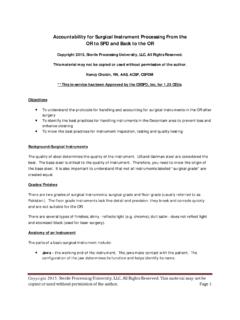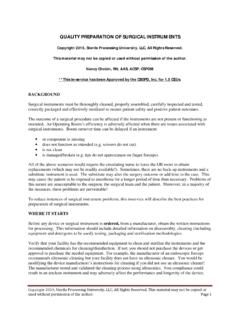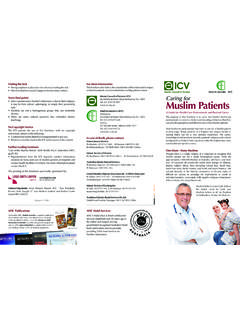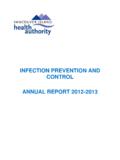Transcription of Best Practices for Loaner Surgical Instruments - …
1 Copyright 2015, Sterile Processing University, LLC, All Rights Reserved. This material may not be copied or used without permission of the author. Page 1 best Practices for Loaner Surgical Instruments Copyright 2015, Sterile Processing University, LLC, All Rights Reserved. This material may not be copied or used without permission of the author. Nancy Chobin, RN, AAS, ACSP, CSPDM **This in-service has been Approved by the CBSPD, Inc. for CEUs. Objectives To define Loaner Instruments To review the accountability issues with Loaner Instruments To discuss best Practices for management of Loaner Instruments Loaner Instruments are Instruments the facility did not purchase.
2 They are most often are used for specialty type surgery ( spinal, total joint). It is difficult for facilities to inventory these specialty types of Instruments due to the routine changes in sets and the variety of devices. Therefore companies loan them to healthcare facilities. Sometimes sets are left at the facility as loaners. These are considered consignment Instruments . Consigned inventory is the property of the vendor, not the facility, until it is sold by the vendor. The facility does not own the inventory but agrees to pay for it upon use.
3 The facility is totally responsible for the consignment Instruments /implants left at the facility. There needs to be effective management of Loaner instrumentation and implants for specialty operative procedures including proper inventory, cleaning and sterilization. Sterile Processing and Operating Room personnel in collaboration with the vendor(s) must work together to see that this inventory is managed correctly to prevent costly delays in the OR and so as to not impact on patient safety. Loaners can be from another hospital (tray/set borrowed from another facility), doctors Instruments (not owned by the hospital), i nstrument company (Orthopedic, Neuro) and a Loaner can be for an instrument that is being repaired, Instruments on consignment.
4 Effective management of Loaner Instruments /implants can prevent a decline in the quality of service and care of patients and to avoid paying for damage/loss that did not occur. We need to develop policies and procedures between the vendors, physicians, Operating Room and Sterile Processing detailing all procedures related to Loaner Instruments . Vendors need to know the amount of time the facility will need to process the Instruments prior to the start of the case ( 48-72 hours). Furthermore, vendors need to comply with these requirements.
5 There should be a system of accountability for vendor compliance. Copyright 2015, Sterile Processing University, LLC, All Rights Reserved. This material may not be copied or used without permission of the author. Page 2 Scheduling - For orthopedic and spinal cases most often 10-30 Loaner trays are brought in for a single case. If multiple cases are scheduled for the same day, this impacts on SPD s ability to process all the loaners in addition to the processing for the other scheduled cases and other processing. It is important for vendors to understand that they must cooperate by delivering the Instruments in sufficient time to permit complete processing according to their instructions for use (IFUs).
6 Failure to do so may negatively impact on patient care because items may have to be sterilized by immediate use steam sterilization (IUSS) which is not the best practice unless it is an emergency. In addition, many Loaner Instruments /sets have not been validated for IUSS. Vendors must provide specific cleaning, assembly and sterilization instructions including: O type of detergents/chemicals recommended O sterilization methodology and parameters (steam (pre-vac or gravity)), ETO, etc. O immediate use sterilization instructions (if validated) O instructions for use (IFUs) Who is reviewing the IFUs to ensure your department/facility can comply or that the IFUs meet AAMI standards?
7 Are the recommended sterilization temperatures ones that can be used in the US? Many IFUs have temperatures of 272o, 273o, 274oF which are not validated temperatures for US steam sterilizers. Some have incorrect exposure times, ( 3 minutes at 270oF, wrapped, pre-vacuum). Is there time to contact the company to resolve the issue? Many IFUs recommend an extended exposure time ( 8 minutes at 270oF, pre-vacuum.) Have your sterilizers been set-up for extended cycles? Has the staff been inserviced with competencies verified in extended cycles?
8 Is the staff aware that only those sets requiring the extended cycle can be included in the load? Cleaning - Decontamination personnel must follow manufacturers' cleaning IFU and to do so must have access to them. Also required are the necessary resources to comply with the IFUs: O Sufficient ultrasonic cleaners extended sonic cycles O Sufficient washers O Sufficient staffing O Sufficient sterilization capacity Problems occur when trays arrive too late before the procedure. This can lead to the staff feeling pressured into getting the sets processed.
9 This can create errors and can cause taking short-cuts of vital processing steps. Another issue is insufficient time to be able to inservice SPD if there are new sets/devices. Copyright 2015, Sterile Processing University, LLC, All Rights Reserved. This material may not be copied or used without permission of the author. Page 3 Photo Above - Bone Inside Reamer staff not inserviced prior to cleaning. Did not know how to disassemble the reamer. Photo Above - Debris inside Loaner set brought into facility wrapped and sterile Factors: 1.
10 Sufficient time is needed to review the sets with SPD staff. Cleaning protocols are essential. Was an inservice provided by the vendor for new trays? Was the training hands-on? Who monitors staff Practices ? Copyright 2015, Sterile Processing University, LLC, All Rights Reserved. This material may not be copied or used without permission of the author. Page 4 Photo above: Loaner Sets washed with lid beneath the container; set inside the container; not removed from container for cleaning. 2. Can you dry the sets under your department s conditions?

